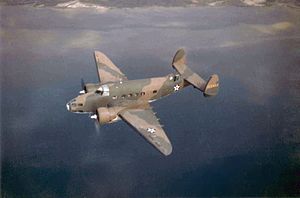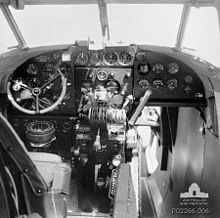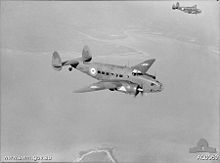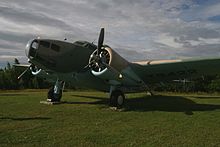- Lockheed Hudson
-
Hudson
A-28 / A-29 / AT-18Lockheed A-29 Hudson Role Bomber, reconnaissance aircraft Manufacturer Lockheed Designer Clarence "Kelly" Johnson First flight 10 December 1938 Introduction 1939 Primary users Royal Air Force
Royal Canadian Air Force
Royal Australian Air Force
United States Army Air Forces
Royal New Zealand Air ForceProduced 1938–1942 Number built 2,584 Developed from Lockheed Model 14 Super Electra The Lockheed Hudson was an American-built light bomber and coastal reconnaissance aircraft built initially for the Royal Air Force shortly before the outbreak of the Second World War and primarily operated by the RAF thereafter. The Hudson was the first significant aircraft construction contract for the Lockheed Aircraft Corporation—the initial RAF order for 200 Hudsons far surpassed any previous order the company had received. The Hudson served throughout the war, mainly with Coastal Command but also in transport and training roles as well as delivering agents into occupied France. They were also used extensively with the Royal Canadian Air Force's anti-submarine squadrons.
Contents
Design and development
In late 1937 Lockheed sent a cutaway drawing of the Model 14 to various publication showing the new aircraft as a civilian aircraft and converted to a light bomber.[1] This attracted the interest of various air forces and in 1938, the British Purchasing Commission sought an American maritime patrol aircraft for the United Kingdom to support the Avro Anson. On 10 December 1938, Lockheed demonstrated a modified version of the Lockheed Model 14 Super Electra commercial airliner, which swiftly went into production as the Hudson Mk I.[2]
A total of 350 Mk I and 20 Mk II Hudsons were supplied (the Mk II had different propellers). These had two fixed Browning machine guns in the nose and two more in the Boulton Paul dorsal turret. The Hudson Mk III added one ventral and two beam machine guns and replaced the 1,100 hp Wright Cyclone 9-cylinder radials with 1,200 hp versions (428 produced).
The Hudson Mk V (309 produced) and Mk VI (450 produced) were powered by the 1,200 hp Pratt & Whitney Twin Wasp 14-cylinder two-row radial. The RAF also obtained 380 Mk IIIA and 30 Mk IV Hudsons under the Lend-Lease programme.
Operational history
By February 1939, RAF Hudsons began to be delivered, initially equipping No. 224 Squadron RAF at RAF Leuchars, Scotland in May 1939. By the start of the war in September, 78 Hudsons were in service. Due to the United States then-neutrality, early series aircraft were flown to the Canadian border, landed, and then towed on their wheels over the border into Canada by tractors or horse drawn teams, before then being flown to RCAF airfields where they were then dismantled and "cocooned" for transport as deck cargo, by ship to Liverpool. The Hudsons were supplied without the Boulton Paul dorsal turret, which was installed on arrival in the United Kingdom.
Although later outclassed by larger bombers, the Hudson achieved some significant feats during the first half of the war. On 8 October 1939, over Jutland, a Hudson became the first RAF aircraft to shoot down a German aircraft. (The first British aircraft to shoot down a German plane was a Blackburn Skua of the Fleet Air Arm on 26 September 1939.) They operated as fighters during the Battle of Dunkirk. A PBO-1 Hudson of US Navy squadron VP-82 became the first US aircraft to destroy a German submarine [3] when it sank U-656 southwest of Newfoundland on 1 March 1942. A Hudson of Royal Canadian Air Force Bomber Reconnaissance Squadron 113 became the first aircraft of RCAF's Eastern Air Command to sink a submarine, when Hudson 625 sank U-754 on 31 July 1942.[4]
A Royal Australian Air Force Hudson was involved in the Canberra, Australia air disaster of 1940, in which three cabinet ministers of the Australian government were killed.
In 1941, the USAAF began operating the Hudson; the Twin Wasp-powered variant was designated the A-28 (82 acquired) and the Cyclone-powered variant was designated the A-29 (418 acquired). The US Navy operated 20 A-28s, redesignated the PBO-1. A further 300 were built as aircrew trainers, designated the AT-18.
Following Japanese attacks on Malaya, Hudsons from No. 1 Squadron RAAF became the first aircraft to make an attack in the Pacific War, sinking a Japanese transport ship, the Awazisan Maru, off Kota Bharu, an hour before the attack on Pearl Harbor. If this occurred one hour before the Pearl Harbor attack it would have been 0118 local time, an extraordinary night operation.
A Hudson was the first Royal New Zealand Air Force aircraft in air combat in the Pacific theatre when on 23 Nov 1942.[5] F/O George Gudsell's NZ2049[6] was engaged by three Japanese floatplane fighters after spotting an enemy convoy near Vella Lavella. After skilled evasive manoeuvring at less than 50' above the sea, the Hudson returned to Henderson Field with no casualties.
During the war, they were used as maritime patrol aircraft in the Pacific by the US Navy, the RAAF and the RNZAF.
While running on the surface off Cape Hatteras on 7 July 1942, U-701 was attacked by a Hudson of 396 Sqdn USAAF. She was hit by two bombs and sunk.
They were operated by RAF Special Duties squadrons for clandestine operations; No. 161 Squadron in Europe and No. 357 Squadron in Burma.
A total of 2,584 Hudsons were built. They began to be withdrawn from front line service in 1944.
The type formed the basis for development of the Lockheed Ventura.
Some Hudsons were converted to civil transports after the war.
Variants
- Hudson I
- Production aircraft for the Royal Air Force; 351 built and 50 for the Royal Australian Air Force
- Hudson II
- As the Mk I but with spinnerless constant speed propellers; 20 built for the RAF and 50 for the RAAF.
- Hudson III
- Production aircraft with retractable ventral gun position; 428 built.
- Hudson IIIA
- Lend-lease variants of the A-29 and A-29A aircraft; 800 built.
- Hudson IV
- As Mk II with ventral gun removed; 30 built and RAAF Mk I and IIs were converted to this standard.
- Hudson IVA
- 52 A-28s delivered to the RAAF.
- Hudson V
- Mk III with two 1,200 hp R-1830-S3C4-G engine; 409 built.
- Hudson VI
- A-28As under lend-lease; 450 built.
- A-28
- US Military powered by two 1,050hp R-1830-45 engines; 52 delivered to Australia as Hudson IVA.
- A-28A
- A-28 with convertible interiors as troop transports; 450 delivered to RAF as Hudson VI; 27 units passed to the Brazilian Air Force
- A-29
- A-28 powered by two 1,200 hp R-1820-87 engines; 416 built for the RAF, 153 diverted to USAAF as the RA-29 and 20 to the United States Navy as the PBO-1
- A-29A
- A-29 with convertible interiors as troop transports; 384 to the RAF as Hudson IIIA, some retained by USAAF as the RA-29A.
- A-29B
- 24 repossesed A-29s converted for photo-survey.
- AT-18
- Gunnery trainer version of the A-29 powered by two R-1820-87 engines, 217 built.
- AT-18A
- Navigational trainer version with dorsal turret removed, 83 built.
- C-63
- Provisional designation changed to A-29A.
- C-111
- Three civil Model 14s impressed in Australia.
- PBO-1
- Twenty former RAF Hudson IIIAs repossesed for use by VP-82 Squadron of the United States Navy
Operators
- Brazilian Air Force
- 2nd Bomb Group Average (27 units A-28A)
11 Squadron (Hudson I & III)
- Chinese Nationalist Air Force
- Portugal Air Force
- Royal Air Force
- No. 24 Squadron RAF
- No. 48 Squadron RAF
- No. 53 Squadron RAF
- No. 59 Squadron RAF
- No. 62 Squadron RAF
- No. 117 Squadron RAF
- No. 139 Squadron RAF
- No. 161 Squadron RAF
- No. 163 Squadron RAF
- No. 194 Squadron RAF
- No. 200 Squadron RAF
- No. 203 Squadron RAF
- No. 206 Squadron RAF
- No. 212 Squadron RAF
- No. 217 Squadron RAF
- No. 220 Squadron RAF
- No. 224 Squadron RAF
- No. 231 Squadron RAF
- No. 233 Squadron RAF
- No. 251 Squadron RAF
- No. 267 Squadron RAF
- No. 269 Squadron RAF
- No. 271 Squadron RAF
- No. 279 Squadron RAF
- No. 285 Squadron RAF
- No. 287 Squadron RAF
- No. 288 Squadron RAF
- No. 289 Squadron RAF
- No. 353 Squadron RAF
- No. 357 Squadron RAF
- No. 500 Squadron RAF
- No. 517 Squadron RAF
- No. 519 Squadron RAF
- No. 520 Squadron RAF
- No. 521 Squadron RAF
- No. 608 Squadron RAF
- Sperry Gyroscope
- United States Army Air Forces
- United States Navy
Civil operators
- British West Indian Airways
Survivors
- Australia
- RAAF Hudsons can be found at the Temora Aviation Museum, the Australian War Memorial and the RAAF Museum. Other ex-RNZAF and RAAF machines are in private hands. The Hudson at Temora had previously been converted for passenger use and flown by East-West Airlines.
- Canada
- One complete and several partial Hudsons also exist in Canada. A Lockheed Hudson Mk IIIA (T9422) after years mounted on a pedestal near Washington Street, is on outdoor display at the North Atlantic Aviation Museum, Gander, Newfoundland.
- New Zealand
- Former Royal New Zealand Air Force Hudsons which saw service during the Second World War in the South Pacific are on display at the Royal New Zealand Air Force Museum and Ferrymead Heritage Park in Christchurch and the Museum of Transport and Technology in Auckland.
- United Kingdom
- A Hudson in Royal Australian Air Force colours is preserved in the Royal Air Force Museum at Hendon.
Specifications (Hudson Mk I)
Data from[citation needed]
General characteristics
- Crew: 6
- Length: 44 ft 4 in (13.51 m)
- Wingspan: 65 ft 6 in (19.96 m)
- Height: 11 ft 10 in (3.62 m)
- Wing area: 551 ft² (51.2 m²)
- Empty weight: 12,000 lb (5,400 kg)
- Loaded weight: 17,500 lb (7,930 kg)
- Max takeoff weight: 18,500 lb (8,390 kg)
- Powerplant: 2 × Wright Cyclone 9-cylinder radial engines, 1,100 hp (820 kW) each
Performance
- Maximum speed: 218 kt (246 mph, 397 km/h)
- Range: 1,700 nm (1,960 mi, 3,150 km)
- Service ceiling: 24,500 ft (7,470 m)
- Rate of climb: 1,200 ft/min (6.2 m/s)
Armament
- Guns:
- 2 × .303 in (7.7 mm) Browning machine guns in dorsal turret
- 2× .303 Browning machine guns in nose
- Bombs: 750 lb (340 kg) of bombs or depth charges
Notable appearances in media
- In the 1941 film A Yank in the RAF with Tyrone Power and Betty Grable, Lockheed Hudsons are the bombers flown by Power and his squadron.
- The Lockheed Hudson features prominently in the Captains of the Clouds (1942). The film starred James Cagney and Dennis Morgan as Canadian bush pilots who do their part in the Second World War as ferry pilots, bringing Hudsons to Britain. The film ends with a depiction of a Hudson ferry flight that mixes authentic live action with studio footage.
- Above and Beyond (2006), a Canadian Broadcasting Corporation (CBC) four-hour mini series, was inspired by the true story of the Atlantic Ferry Organization, recounting the daring plan to deliver aircraft across the North Atlantic to the beleaguered Royal Air Force. The Lockheed Hudson is the primary aircraft portrayed in the mini series in the form of a real life example and numerous CGI Hudsons.[7]
- A de-militarized Hudson is flown by Humphrey Bogart's character in Tokyo Joe (1949). Bogart played an ex-World War II pilot attempting to operate a cargo airline in occupied Japan. The Hudson is identifiable by the turret platform at the rear of the fuselage, and by the numerous windows in the cockpit area.
- The Lockheed Hudson was featured in the movie The Great Raid as a distraction to Japanese soldiers, although in the real event, a P-61 Black Widow was used. The Hudson was used instead because there were no airworthy Black Widows at the time of the movie's filming.
See also
- Related development
- Lockheed Model 14 Super Electra
- Lockheed Ventura
- Aircraft of comparable role, configuration and era
- Related lists
- List of aircraft of the RAF
- List of aircraft of the RNZAF
- List of military aircraft of the United States
- List of Lockheed aircraft
References
- Notes
- ^ "New Transport Plane Can Be Converted To Bomber" Popular Science Monthly, November 1937
- ^ "British Buy Dual Purpose War Planes" Popular Science, August 1939
- ^ Swanborough and Bowers 1976, p. 505.
- ^ Douglas 1986, p. 520.
- ^ "A Veteran's Advice." rsa.org.nz. Retrieved: 15 July 2010.
- ^ "RNZAF Hudson Survivors." cambridgeairforce.or. Retrieved: 15 July 2010.
- ^ "Above & Beyond." CBC.ca. Retrieved: 15 July 2010.
- Bibliography
- Douglas, W.A.B.The Creation of a National Air Force. Toronto: University of Toronto Press, 1986.
- Swanborough, Gordon, and Peter M. Bowers. United States Navy Aircraft since 1911. Annapolis, Maryland: Naval Institute Press, 1976. ISBN 0-87021-792-5.
- Vincent, David. The RAAF Hudson Story: Book One Highbury, South Australia: David Vincent, 1999 ISBN 0 9596052 2 3
External links
Lockheed and Lockheed Martin aircraft Manufacturer
designationsBasic Model
NumbersL-1 · L-2 · L-3 · L-4 · L-5 · L-7 · L-8 · L-9 · L-10 · L-11 · L-012 · (L-013 not assigned) · L-014 · L-015 · L-016 · L-017 · L-018 · L-019 · L-020 · L-021 · L-022 · L-023 · L-024 · (L-025 not assigned) · L-026 · L-027 · (L-028 not assigned) · L-029 · L-030 · L-031 · L-032 · L-033 · L-034 · L-035 · (L-036 not assigned) · L-037 · (L-038 and L-039 not assigned) · L-040 · L-041 · L-042 · L-044 · L-045 · L-049 · L-050 · L-051 · L-052 · L-060 · L-061 · L-062 · L-075 · L-080 · L-081 · L-082 · L-083 · L-084 · L-085 · L-086 · L-087 · L-088 · L-089 · L-090 · L-091 · L-092 · L-093 · L-094 · L-092 · L-099 · L-100 · L-133 · L-140 · L-141 · L-193 · L-245 · L-246 · L-300 · L-301 · L-329 · L-351 · L-382 · L-500 · L-645
Lockheed-California
Temporary Design
NumbersBy role Airliners and
civil transportsVega · Sirius · Altair · Orion · Electra · Electra Junior · Super Electra · Lodestar · Constellation (L-049 · L-649 · L-749) · Super Constellation (L-1049 · L-1249) · Starliner · Saturn · Electra · L-402 · JetStar · L-100 · L-1011
Military transportsY1C-12 · Y1C-17 · Y1C-23 · Y1C-25 · C-36 · C-37 · C-40 · C-56 · C-57 · C-59 · C-60 · C-63 · C-66 · C-69 · UC-85 · UC-101 · C-104 · C-111 · C-121 · C-130 / C-130J / HC-130 / KC-130 / LC-130 / MC-130 · C-139 · C-140 · C-141 · C-5 · JO · XRO · R2O · R3O · XR4O · R5O · R6O / R6V · R7O / R7V · R8V / GV / UV · TriStar
Attack and bombersDrones/UAVsEW and
reconnaissanceFightersHelicoptersMaritime patrolTrainersAT-18 · T-33 · T-40 · TO / TV · T2V / T-1
ExperimentalNames Air Express · Aquila · Altair · Aurora · Big Dipper · Blackbird · Chain Lightning · Cheyenne · Constellation (L-049 · L-649 · L-749) · Constitution · Electra (Model 10) · Electra (Model 88) · Electra Junior · Excalibur · Explorer · Fighting Falcon · Galaxy · Have Blue · Hercules · Hudson · Hummingbird · JetStar · Kestrel · Kingfisher · Lightning · Lightning II · Little Dipper · Lodestar · Neptune · Orion (Model 9) · Orion (P-3) · Polecat · Raptor · Saturn · SeaStar · Sentinel · Shooting Star · Sirius · Starfighter · Starfire · Starlifter · Starliner · Super Constellation (L-1049 · L-1249) · Super Electra · Super Galaxy · Super Hercules · Tristar · Vega · Ventura · Viking · Warning Star
USAAS/USAAC/USAAF/USAF attack aircraft designations 1924–1962 (A-1 not assigned) • XA-2 • A-3 • A-4 • A-5 • A-6 • XA-7 • A-8 • XA-9 • YA-10 • XA-11 • A-12 • YA-13 • YA-14 • XA-15 • XA-16 • A-17 • A-18 • A-19 • A-20 • XA-21 • A-22 • A-23 • A-24 • A-25 • A-26 • A-27 • A-28 • A-29 • A-30 • A-31 • XA-32 • A-33 • A-34 • A-35 • A-36 • XA-37 • XA-38 • XA-39 • A-40 • XA-41 • XA-42 • XA-43 • XA-44 • XA-45
USAAC/USAAF/USAF/Tri-service trainer aircraft Advanced Trainer Basic Combat Basic Trainer Primary Trainer (1924-1948) Trainer (1948-1990) "T-1", "T-2", "T-3" and "T-6" have also been assigned since 1962 in a separate sequence. USAAS/USAAC/USAAF/USAF transport designations 1925–1962, 2005-2006 Main sequence
1925-1962C-1 • C-2 • C-3 • C-4 • C-5 • C-6 • C-7 • C-8 • C-9 • XC-10 • Y1C-11 • Y1C-12 • C-13 (Not assigned) • C-14 • C-15 • C-16 • Y1C-17 • C-18 • C-19 • C-20 • C-21 • Y1C-22 • Y1C-23 • Y1C-24 • Y1C-25 • C-26 • C-27 • C-28 • C-29 • YC-30 • C-31 • C-32 • C-33 • C-34 • XC-35 • C-36 • C-37 • C-38 • C-39 • C-40 • C-41/A • C-42 • UC-43 • C-44 • C-45 • C-46 • C-47 • C-48 • C-49 • C-50 • C-51 • C-52 • C-53 • C-54 • C-55 • C-56 • C-57 • C-58 • C-59 • C-60 • UC-61 • C-62 • C-63 • C-64 • C-65 • C-66 • UC-67 • C-68 • C-69 • UC-70/A/B/C/D • UC-71 • UC-72 • C-73 • C-74 • C-75 • C-76 • UC-77 • C-78 • C-79 • C-80 • UC-81 • C-82 • C-83 • C-84 • UC-85 • C-86 • C-87 • C-88 • C-89 • C-90 • C-91 • UC-92 • C-93 • UC-94 • UC-95 • UC-96 • KC-/C-97 • C-98 • XC-99 • UC-100 • UC-101 • C-102 • UC-103 • C-104 • C-105 • C-106 • C-107 • C-108 • C-109 • C-110 • C-111 • XC-112 • XC-113 • XC-114 • XC-115 • XC-116 • C-117 • C-118 • C-119 • XC-120 • C-121/F • YC-122 • C-123/A • C-124 • YC-125 • LC-126 • C-127 (I) • C-127 (II) • C-128 • YC-129 • C-130 • C-131 • C-132 • C-133 • YC-134 • KC-/C-135 • C-136 • C-137 • C-138 (Not assigned) • C-139 (Not assigned) • C-140 • C-141 • XC-142
Revived sequence
2005-2006C-143 • C-144
See also: Post-1962 list USN/USMC patrol aircraft designations 1923-1962 Patrol HallKeystonePN • P2N • P4N
LockheedPOSikorskyPS • P2S
LockheedPatrol Bomber XPBB • PB2B
LockheedPBOSikorskyPBSVickers CanadaPatrol Torpedo Bomber HallLists relating to aviation General Aircraft (manufacturers) · Aircraft engines (manufacturers) · Airlines (defunct) · Airports · Civil authorities · Museums · Registration prefixes · Rotorcraft (manufacturers) · TimelineMilitary Accidents/incidents Records Categories:- Lockheed aircraft
- United States patrol aircraft 1930–1939
- World War II patrol aircraft of the United States
Wikimedia Foundation. 2010.










